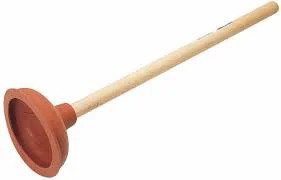Few things can ruin your day faster than a clogged toilet. Luckily, most homes are equipped plungers to fix the situation before it gets messy. However, how many people have the right kind of toilet plunger? How do you “plunge” anyway? Read on to learn the basics and develop your knowledge of plunging a clogged toilet, one of the great life skills. First, what kind of plunger should you use? Below is a description for the different types of plungers, as well as an instructional video on how to save the day with a toilet plunger.
There are essentially three types of plungers: Sink plungers, toilet plungers and accordion plungers.
Sink Plungers

Plunger
This is the kind of plunger most of us are familiar with. This standard plunger usually has a wooden handle with a rubber cup on the end. They are actually designed for use on flat surfaces (IE sinks) although many folks still use them for toilets. You will find that while standard plungers can be effective at clearing toilet drains, it’s much better to use a plunger designed for toilets, such as the other two discussed here.
Flange Plungers

Flange Plunger
These plungers are similar to sink plungers but come with a few key features making them more effective with toilets. The most important of which is a flange designed to fit into the toilet drain. This flap helps concentrate water pressure and can also be modified to fit over other drains, such as sinks or some floor drains. This is probably the most versatile plunger to have as it can deal with most drains and with toilets.
Accordion Plungers

Accordion Plunger
The accordion plungers are high performance tools made specifically for toilets. As the name suggests, these plungers have an accordion style design which sucks up water and then channels it back into the drain, similar to a bellows. In addition, the flange on these plungers is slightly smaller than toilet plungers, helping them fit into the toilet drain more easily. These are likely the best plungers for toilets, but don’t have much purpose outside of the bathroom.
Technique
Proper plunging involves more than simply jamming the plumber repeatedly over the train. The goal of plunging is direct water enough force into the drain that it dislodges any stoppages caused by clogs. Simply pounding the plunger up and down may feel productive, but a little forethought goes a long way. When plunging, try to make the plunger suck in as much water as possible and try to force that captured water down the drain.

